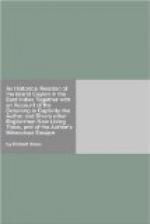There are other Trees remarkable either for their strangeness, or use, or both. Of these I shall mention a few.
[The Orula, the Fruit good for Physick, and Dying.] The Orula, a Tree as big as an Apple-Tree, bears a Berry somewhat like an Olive, but sharper at each end, its Skin is of a reddish green colour, which covereth an hard stone. They make use of it for Physic in Purges; and also to dy black colour: Which they do after this manner; They take the fruit and beat it to pieces in Mortars, and put it thus beaten into water; and after it has been soaking a day or two, it changeth the water, that it looks like Beer. Then they dip their cloth in it, or what they mean to dy, and dry it in the Sun. And then they dip it in black mud, and so let it ly about an hour, then take it and wash it in water: and now it will appear of a pale black. Then being dry, they dip it again into the aforesaid Dy, and it becomes a very good black.
[This water will brighten rusty Iron, and serve instead of Ink.] Another use there is of this water. It is this: Let any rusty Iron ly a whole night in it, and it will become bright; and the water look black like Ink, insomuch that men may write with it. These Trees grow but in some Parts of the Land, and nothing near so plentiful as Cinnamon. The Berries the Drugsters in the City there, do sell in their Shops.
[The Dounekaia] The Dounekaia gauhah, a shrub, bears leaves as broad as two fingers, and six or eight foot long, on both sides of them set full of Thorns, and a streak of Thorns runs thro the middle. These leaves they split to weave Matts withal. The Tree bears a bud above a span long, tapering somewhat like a Sugar-loaf. Leaves cover this bud folding it about, like the leaves of a Cabbage. Which leaves smell rarely sweet, and look of a lovely yellow colour like gold. This bud blowes into divers bunches of Flowers, spreading it self open like a Plume of Feathers, each Flower whitish, but very small. The Roots of this shrub they use for Ropes, splitting them into Thongs, and then making them into Ropes.
[The Capita.] The Capita gauhah, is a shrub never bigger than a mans arm. The Wood, Rind and Leaves have all a Physical smell; and they do sometimes make use of it for Physic. The Leaf is of a bright green, roundish, rough, and as big as the palm of an hand. No sort of Cattel will eat it, no, not the Goats, that will sometimes brouze upon rank poyson. There is abundance of these Trees every where, and they grow in all Countreys, but in Ouvah. And this is supposed to be the cause, that the Ouvah Cattle dy, when they are brought thence to any other Country. They attribute it to the smell of this Tree, of such a venomous nature it is to Beasts. And therefore to destroy their Fleas, or to keep their houses clear of them, they sweep them with Brooms made of this shrub. ’Tis excellent good for firing, and will burn when it is green. There are no other coals the Goldsmiths use, but what are made of this wood.




